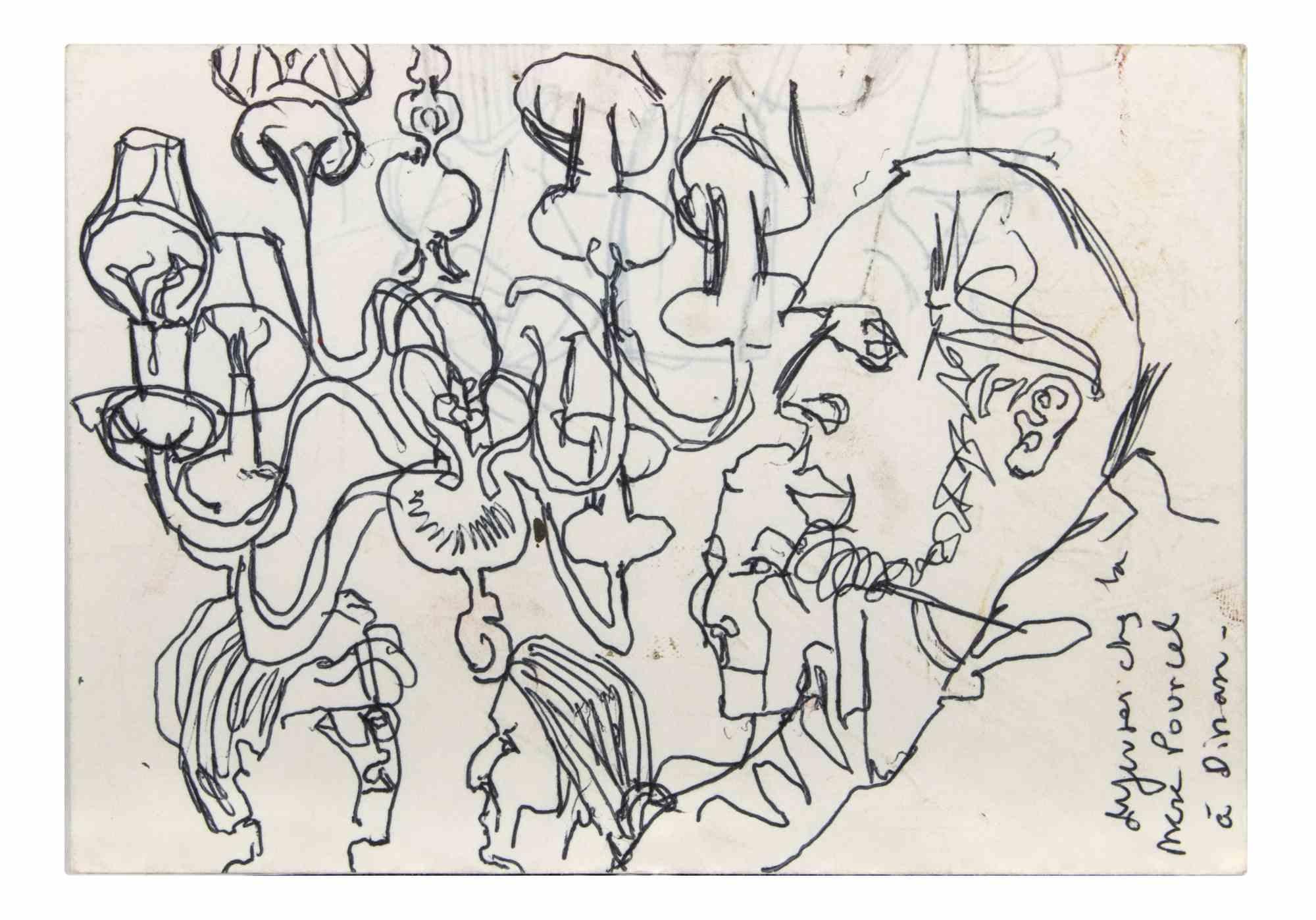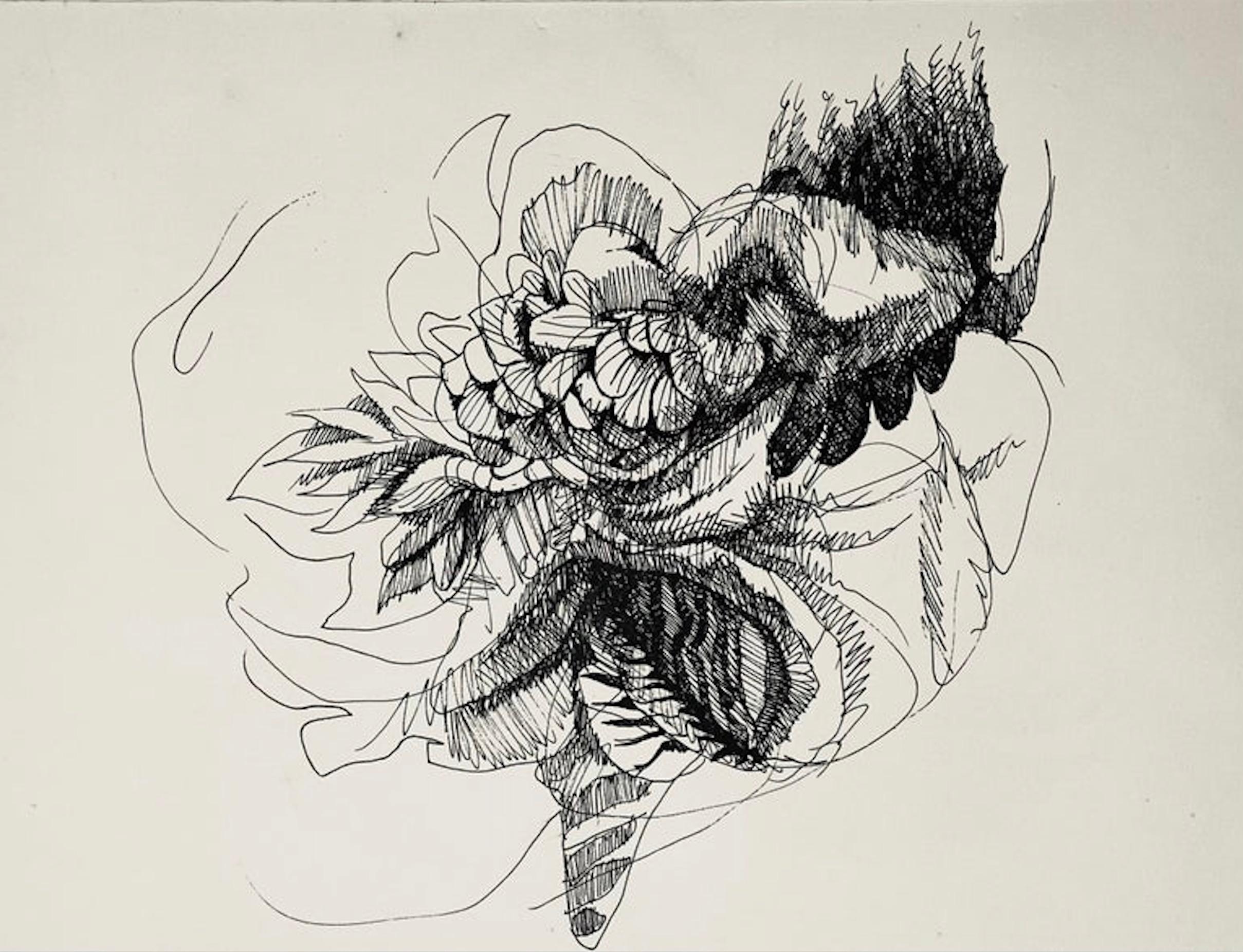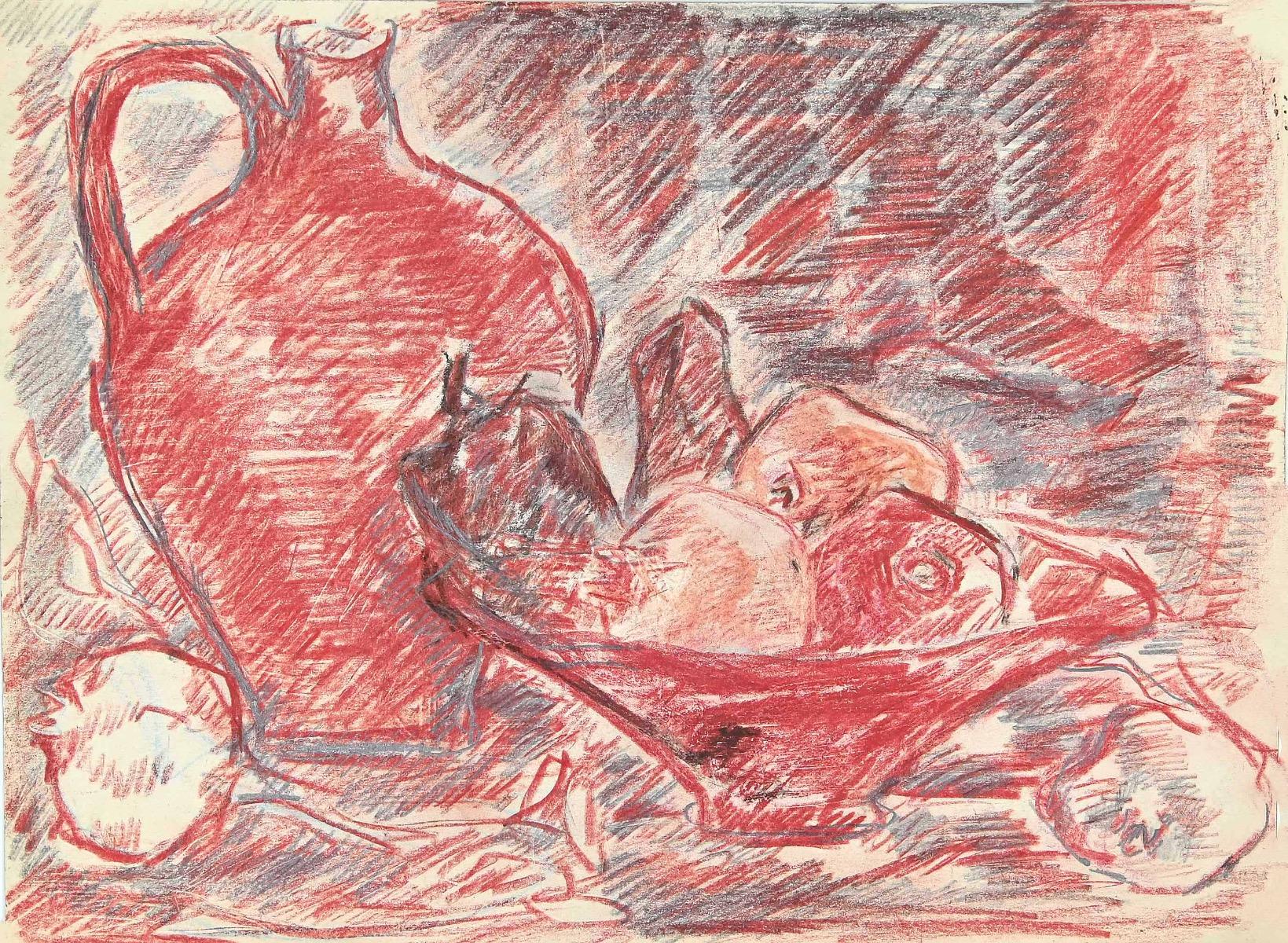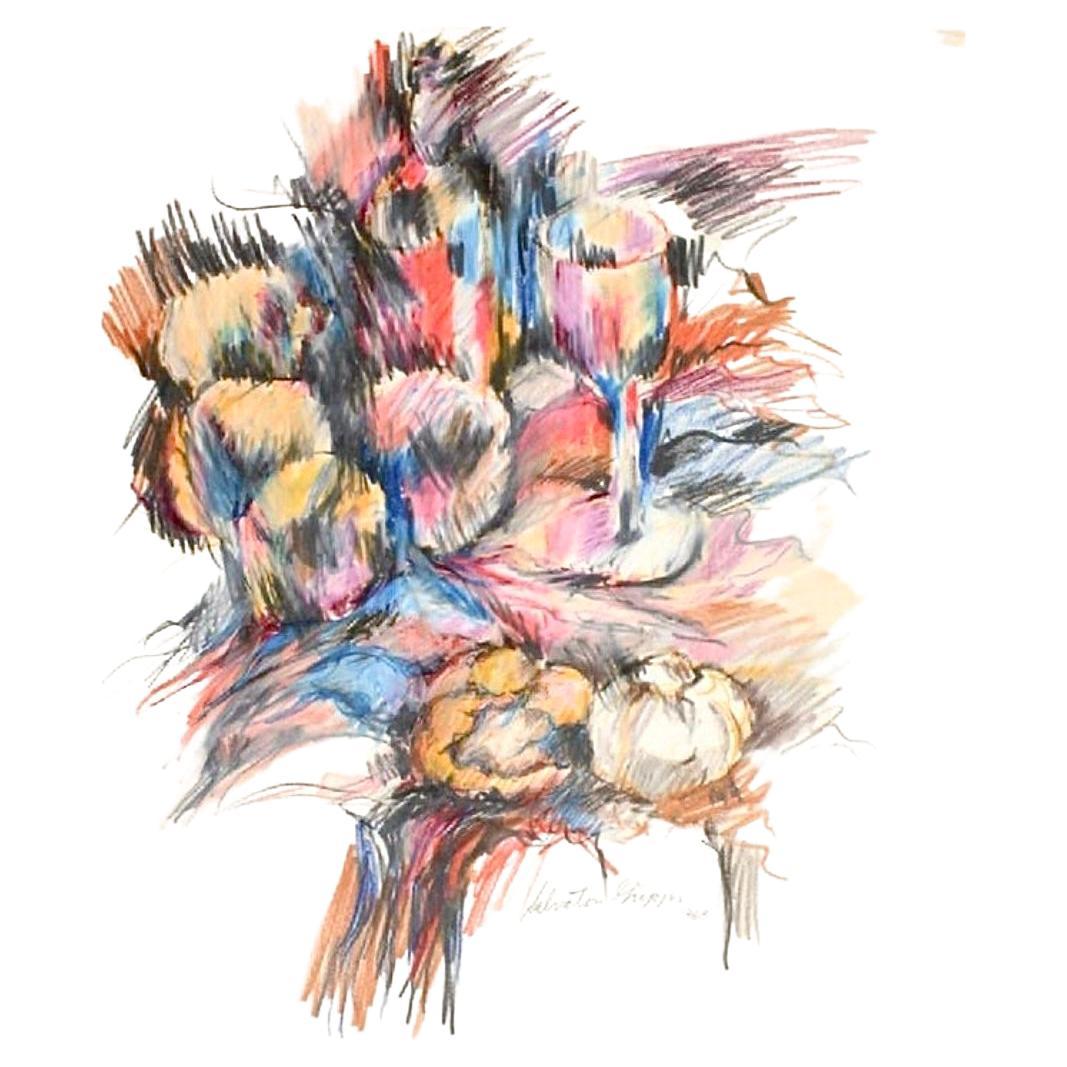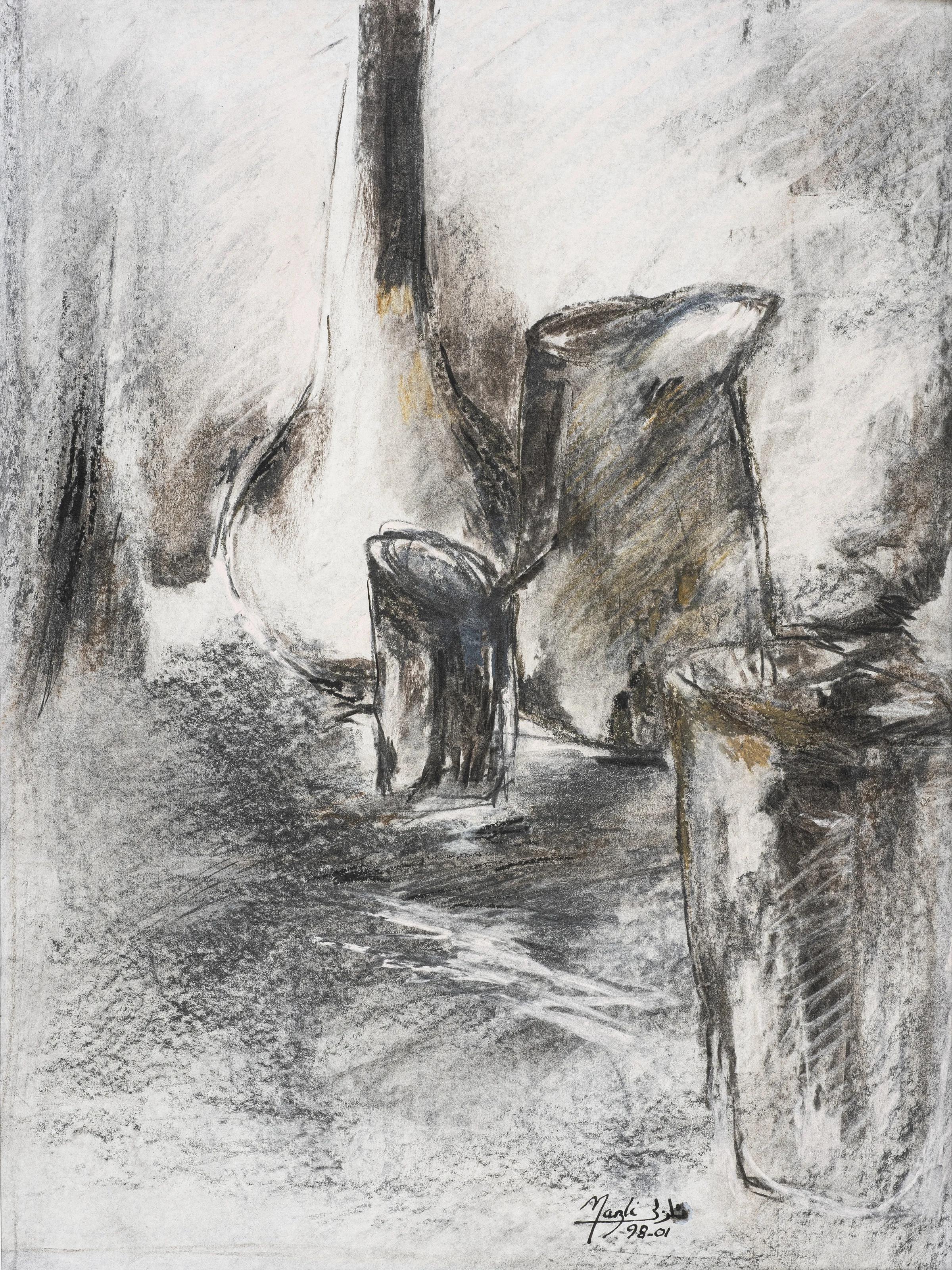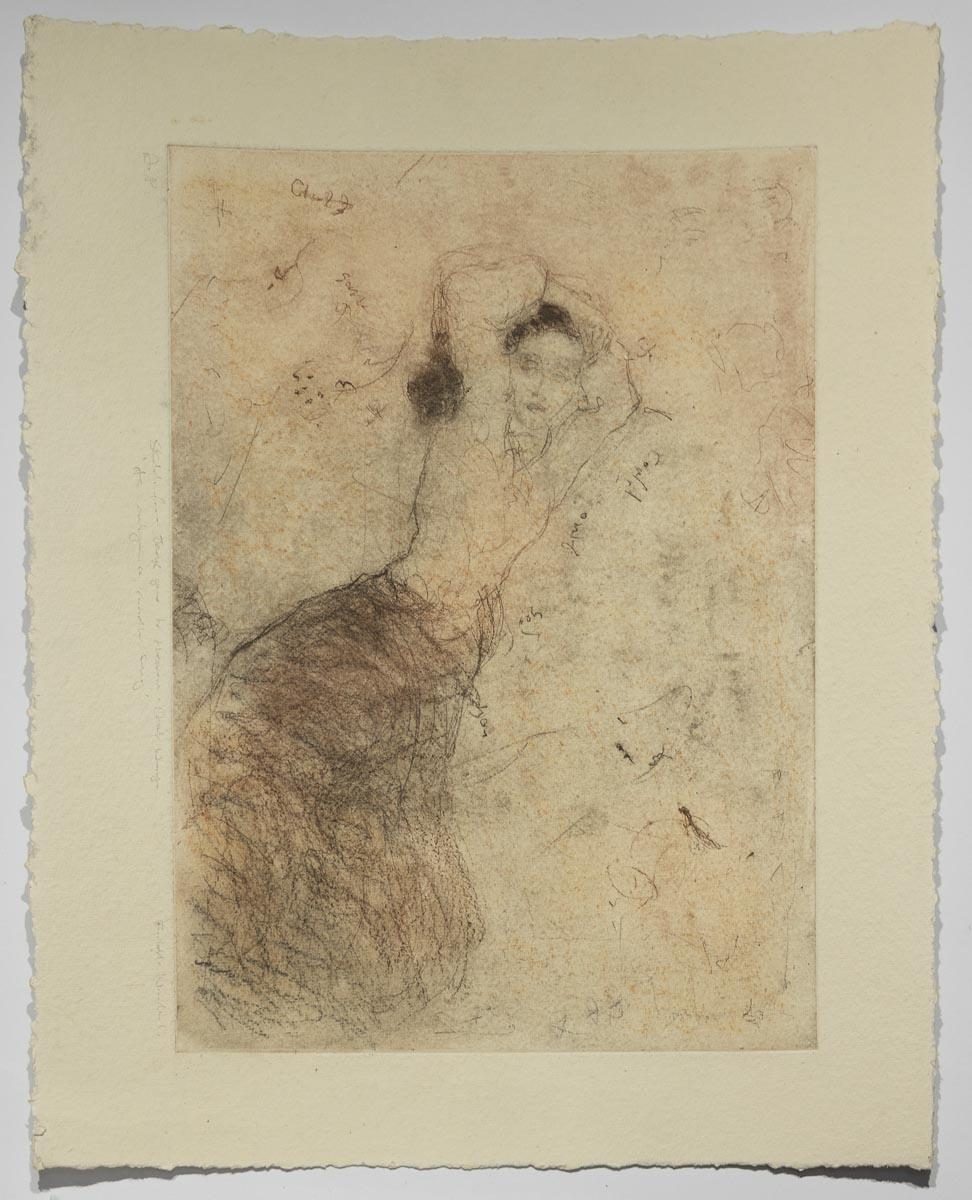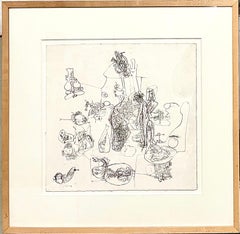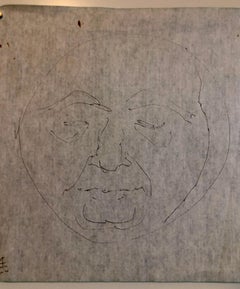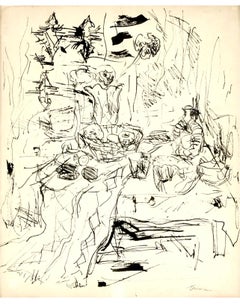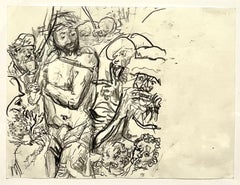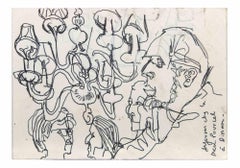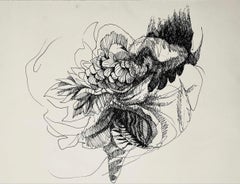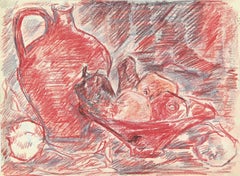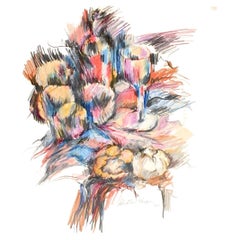Items Similar to Boston Expressionist Conte Pencil Drawing "Still Life with Flies" Hyman Bloom
Want more images or videos?
Request additional images or videos from the seller
1 of 11
Hyman BloomBoston Expressionist Conte Pencil Drawing "Still Life with Flies" Hyman Bloom
$2,800
£2,126.83
€2,450.83
CA$3,943.09
A$4,371.50
CHF 2,297.39
MX$53,500.02
NOK 28,692.13
SEK 26,930.43
DKK 18,293.91
About the Item
Hyman Bloom
"Still Life with Flies"
Frame: 18" X 16"
Image: 9.25" X 8.25"
Hand signed with his monogram initials
Provenance: bears exhibition label from Fuller Museum of Art
Hyman Bloom (March 29, 1913 – August 26, 2009) was a Latvian-born (born Hyman Melamed) American painter. His work was influenced by his Jewish heritage and Eastern religions as well as by artists including Altdorfer, Grünewald, Caravaggio, Rembrandt, Blake, Bresdin, James Ensor and Chaim Soutine. He first came to prominence when his work was included in the 1942 Museum of Modern Art exhibition "Americans 1942 -- 18 Artists from 9 States". MoMA purchased 2 paintings from the exhibition and Time magazine singled him out as a "striking discovery" in their exhibition review. His work was selected for both the 1948 and 1950 Venice Biennale exhibitions along with Willem de Kooning, Lee Gatch, Arshile Gorky, Rico Lebrun, John Marin and Jackson Pollock. Receives grant from the National Academy of Arts and Letters. His 1954 retrospective traveled from Boston's Institute of Contemporary Art to the Albright Gallery and the de Young Museum before closing out at The Whitney Museum of American Art in 1955. In a 1954 interview with Yale art professor Bernard Chaet, Willem de Kooning indicated that he and Jackson Pollock both considered Bloom to be “America’s first abstract expressionist”, a label that Bloom would disavow. Starting in the mid 1950s his work began to shift more towards works on paper and he exclusively focused on drawing throughout the 1960s, returning to painting in 1971. He continued both drawing and painting until his death in 2009 at the age of 9
Hyman Bloom (né Melamed) was born into an orthodox Jewish family in the tiny Jewish village of Brunavišķi in what is now Latvia, then part of the Russian Empire
At a young age Bloom planned to become a rabbi, but his family could not find a suitable teacher. In the eighth grade he received a scholarship to a program for gifted high school students at the Museum of Fine Arts. He attended the Boston High School of Commerce, which was near the museum. He also took art classes at the West End Community Center, a settlement house. The classes were taught by Harold Zimmerman, a student at the School of the Museum of Fine Arts, who also taught the young Jack Levine at another settlement house in Roxbury. When Bloom was fifteen, he and Levine began studying with a well-known Harvard art professor, Denman Ross, who rented a studio for the purpose and paid the boys a weekly stipend to enable them to continue their studies rather than take jobs to support their families.
He took Bloom and Levine on a field trip to the Museum of Modern Art in New York, where Bloom was impressed by the work of Rouault and Soutine and began experimenting with their expressive painting styles.
In the 1930s Bloom worked sporadically for the Public Works of Art Project and the Federal Art Project (WPA), He shared a studio in the South End with Levine and another artist, Betty Chase. It was during this period that he developed a lifelong interest in Eastern philosophy and music, and in Theosophy.
He first received national attention in 1942 when thirteen of his paintings were included in the Museum of Modern Art (MoMA) exhibition Americans 1942: 18 Artists from 9 States, curated by Dorothy Miller. MoMA purchased two of his paintings from that exhibition, and he was featured in Time magazine. The titles of his paintings in the exhibition reflect some of his recurring themes. Two were titled The Synagogue, another, Jew with the Torah; Bloom was actually criticized by one reviewer for including "stereotypical" Jewish images. He also had two paintings titled The Christmas Tree, and another titled The Chandelier, both subjects he returned to repeatedly. Another, Skeleton (c. 1936), was followed by a series of cadaver paintings in the forties, and The Fish (c. 1936) was one of many paintings and drawings of fish he created over the course of his career.
Bloom was associated at first with the growing Abstract Expressionist movement. Willem de Kooning and Jackson Pollock, who first saw Bloom's work at the MoMA exhibition, considered Bloom "the first Abstract Expressionist artist in America." In 1950 he was chosen, along with the likes of de Kooning, Pollock, and Arshile Gorky, to represent the United States at the Venice Biennale. That same year Elaine de Kooning wrote about Bloom in ARTnews, noting that in paintings such as The Harpies, his work approached total abstraction: "the whole impact is carried in the boiling action of the pigment". In 1951 Thomas B. Hess reproduced Bloom's Archaeological Treasure in his first book, Abstract Painting: Background and American Phase, along with works by Pablo Picasso, Jackson Pollock, and others. Both de Kooning and Hess remarked on Bloom's expressive paint handling, a key characteristic of Abstract Expressionist painting.
As abstract expressionism dominated the American art world, Bloom became disenchanted with it, calling it "emotional catharsis, with no intellectual basis." In addition, instead of moving to New York to pursue his career, he opted to stay in Boston. As a result he fell out of favor with critics and never achieved the kind of fame that Pollock and others did. He disliked self-promotion and never placed much value on critical acclaim.
Many of Bloom's paintings feature rabbis, usually holding the Torah. According to Bloom, his intentions were more artistic than religious. He began questioning his Jewish faith early in life, and painted rabbis, he claimed, because that was what he knew. Over the course of his career he produced dozens of paintings of rabbis, some of whom bore no small resemblance to himself. When asked if they were self-portraits, he replied cryptically, "When did I ever paint anything else? The Fuller Museum presented a full retrospective of his work in 1996. Another was organized by the National Academy of Design in New York in 2002.
His work is included in the collections of the Museum of Modern Art, the Boston Museum of Fine Arts, the Art Institute of Chicago, the Whitney Museum of American Art, the Smithsonian's Hirshhorn Museum, the National Academy of Design, and many others. Hyman Bloom: The Beauty of All Things, a film about the artist's life and work, was released in October 2009.
Honors and awards
Critic's Choice Award from the Cincinnati Museum of Art for Christmas Tree, 1945
Guggenheim fellowship, 1949
Academy Award in Art from the American Academy of Arts and Letters, 1953
Ford Foundation fellowship, 1959
Elected to the American Academy of Arts and Letters, 1974
Elected to the National Academy of Design, 1984
Thomas R. Proctor Prize for Jew with Torah from the National Academy of Design, 1999
SELECTED COLLECTIONS
Addison Gallery of American Art, Phillips Academy, Andover, MA
Arkansas Museum of Fine Arts, Little Rock
Art Institute of Chicago
Bowdoin College Museum of Art
DeCordova Sculpture Park and Museum, Lincoln, MA
Danforth Museum of Art, Framingham, MA
Davis Museum, Wellesley College, Wellelsey, MA
Fogg Art Museum, Harvard University
Hirshhorn Museum and Sculpture Garden, Washington, DC
Jewish Museum, New York
Los Angeles County Museum
Minnesota Museum of Art, St. Paul
Museum of Art, University of New Hampshire
Museum of Fine Arts, Boston
Museum of Modern Art, New York MoMA
Museum of the National Academy of Design, New York
Neuberger Museum, Purchase, NY
Princeton Museum of Art, Princeton University
Rose Art Museum, Brandeis University, Waltham, MA
Skirball Museum, Hebrew Union College, Los Angeles, CA
Smart Museum of Art, University of Chicago
Smith College Art Museum, Northampton, MA
Smithsonian American Art Museum
Telfair Museum of Art, Savannah, GA
Whitney Museum of American Art, New York
William Benton Museum of Art, University of Connecticut, Storrs
Worcester Art Museum, Worcester, MA
Yeshiva University Museum, New York
- Creator:Hyman Bloom (1913 - 2009, American)
- Dimensions:Height: 18 in (45.72 cm)Width: 16 in (40.64 cm)
- Medium:
- Movement & Style:
- Period:
- Condition:Please refer to photos.
- Gallery Location:Surfside, FL
- Reference Number:1stDibs: LU38215045312
About the Seller
4.9
Platinum Seller
Premium sellers with a 4.7+ rating and 24-hour response times
Established in 1995
1stDibs seller since 2014
1,801 sales on 1stDibs
Typical response time: <1 hour
- ShippingRetrieving quote...Shipping from: Surfside, FL
- Return Policy
Authenticity Guarantee
In the unlikely event there’s an issue with an item’s authenticity, contact us within 1 year for a full refund. DetailsMoney-Back Guarantee
If your item is not as described, is damaged in transit, or does not arrive, contact us within 7 days for a full refund. Details24-Hour Cancellation
You have a 24-hour grace period in which to reconsider your purchase, with no questions asked.Vetted Professional Sellers
Our world-class sellers must adhere to strict standards for service and quality, maintaining the integrity of our listings.Price-Match Guarantee
If you find that a seller listed the same item for a lower price elsewhere, we’ll match it.Trusted Global Delivery
Our best-in-class carrier network provides specialized shipping options worldwide, including custom delivery.More From This Seller
View AllGerman Neo Expressionist Graphite Pencil Drawing Erwin Pfrang Nolan Gallery NYC
Located in Surfside, FL
Erwin Pfrang, German (b. 1951)
Graphite Pencil on paper
Framed 20 X 20.5, sheet 12.5 X 13
Hand signed lower left
Erwin Pfrang (born 1951, in Munich) is a German painter and printma...
Category
Early 2000s Neo-Expressionist Figurative Drawings and Watercolors
Materials
Paper, Pencil, Graphite
Boston Abstract Expressionist Hyman Bloom Original Pencil Drawing Martin Sumers
By Hyman Bloom
Located in Surfside, FL
This is a unique artwork. This is an original Hyman Bloom drawing of fellow artist and his very good friend Martin Sumers.I believe this was drawn at the “variations of a theme” at S...
Category
20th Century Modern Figurative Drawings and Watercolors
Materials
Paper, Pencil
Original California Figurative Abstract Still Life Ink Drawing Joyce Treiman
By Joyce Treiman
Located in Surfside, FL
Joyce Treiman
Ink on paper, framed under glass; signed in pencil lower right;
Dimensions: 16 1/2 x 13 3/4 inches; 18 3/4 x 14 3/4 inches frame.
Joyce Wahl Treiman was an American painter, printmaker, sculptor and teacher. Her work ranged from "the impishly perverse and humorously paradoxical to the brilliant and profound." She was known as an excellent draftsperson throughout her career. She made several trips to Europe to study the old masters, and the human figure is central in her work. In her later paintings she is known to have inserted self-portraits. She attended Stephens College in Columbia, Missouri, and then studied at the State University of Iowa (today the University of Iowa) under the influential painter Philip Guston. During World War II she worked as a commercial artist but resigned when she began to have success with exhibitions of her work in Chicago and New York.
In 1945 she married Kenneth Treiman, and son Donald, now an Architect, was born in 1950. The Treimans, along with Rene and Rose Wahl, moved to Los Angeles in 1960. She was in an exhibit of Tamarind prints...
Category
Mid-20th Century American Modern Abstract Paintings
Materials
India Ink, Paper
German Neo Expressionist Color Pencil Drawing Erwin Pfrang
Located in Surfside, FL
Erwin Pfrang, German (b. 1951)
Graphite, Colored Pencil on paper
Framed 20.5/8 X 16.5/8 sheet 6 X 7.75
Erwin Pfrang (born 1951, in Munich) is a German painter and printmaker.
Pfra...
Category
1980s Neo-Expressionist Figurative Drawings and Watercolors
Materials
Paper, Pencil, Color Pencil
German Neo Expressionist Graphite Drawing Erwin Pfrang Nolan Eckman Gallery NYC
Located in Surfside, FL
Erwin Pfrang, German (b. 1951)
Graphite on paper
Partner Exchange (2001)
Framed 21 X 14.5 sheet 13.75 X 7.25
Erwin Pfrang (born 1951, in Munich) is a German painter and printmaker...
Category
Early 2000s Neo-Expressionist Figurative Drawings and Watercolors
Materials
Paper, Graphite
Abstract Still Life Oil Painting with Ink Theresa Bernstein Flowers in Vase
By Theresa Bernstein
Located in Surfside, FL
Theresa Bernstein, 1890 - 2002
Abstract Still Life Oil and Pen on Paper Painting (1994) by Theresa Bernstein
Frame: 26" X 22", Image: 18.5" X 14.75"
A Polish born American modernist figurative artist in the traditions of the Ashcan and New York Realism Schools, wife of William Meyerowitz. The artwork represents a still life with two flower vases. Signed by the artist and dated 1994 in the lower left.
Theresa Ferber Bernstein-Meyerowitz (1890 – 2002) was an American artist, writer, and supercentenarian born in Kraków, in what is now Poland, and raised in Philadelphia. She received her art training in Philadelphia and New York City. Over the course of nearly a century, she produced hundreds of paintings and other artwork, plus several books and journals.
Bernstein and her husband William Meyerowitz (a WPA, New deal artist), who was also an artist, lived and worked in Manhattan and Gloucester, Massachusetts. She painted portraits and scenes of daily life, plus reflections of the major issues of her time, in a modern style that evolved from realism to expressionism. She was active in several art associations and promoted her husband's work as well as her own. Her artworks are found in dozens of museums and private collections in the United States and abroad. She remained active all her life and was honored with a solo exhibition of 110 art works to celebrate her 110th birthday.
Bernstein also authored several books, including a biography of her husband and a journal about their many trips to Israel.
She died in 2002, just a couple of weeks short of her 112th birthday.
Theresa Ferber Bernstein was born in Cracow, Poland, on March 1, 1890. She was the only child of Isidore Bernstein, a Jewish textile...
Category
1990s Abstract Abstract Paintings
Materials
Paper, Oil, Pen
You May Also Like
Still Life - Drawing By Reynold Arnould - Mid-20th Century
Located in Roma, IT
Still Life is an Ink and tempera drawing realized by Reynold Arnould (Le Havre 1919 - Parigi 1980).
Good condition on a white envelope.
Titled on the lower right corner, another s...
Category
Mid-20th Century Modern Still-life Drawings and Watercolors
Materials
Paper, Ink, Tempera
(Abstract Still Life) Untitled, 1965, Ian Hornak — Drawing
By Ian Hornak
Located in Fairfield, CT
Artist: Ian Hornak (1944-2002)
Title: (Abstract Still Life) Untitled
Year: circa 1965
Medium: Charcoal on archival paper
Size: 11 x 14 inches
Condition: Good
Provenance: Estate of Ia...
Category
1960s Photorealist Landscape Drawings and Watercolors
Materials
Charcoal, Archival Paper
$3,080 Sale Price
20% Off
Still Life - Original Pastel on Paper by Herta Hausmann - Mid-20th Century
Located in Roma, IT
Still Life is an original pastel drawing on ivory-colored paper realized by Herta Haussmann (1892-1972).
Not signed.
The state of preservation is very good.
Stamp of the artist's ...
Category
Mid-20th Century Modern Figurative Drawings and Watercolors
Materials
Pastel
Abstract Expressionist Still Life Drawing on Paper by Salvatore Grippi, 1960s
By Salvatore Grippi
Located in Brooklyn, NY
Abstract expressionist still life drawing on paper by Salvatore Grippi, 1960s. Gorgeous colored graphite still-life on paper. Signed and dated. From artist’s estate.
Category
Mid-20th Century American Mid-Century Modern Drawings
Materials
Paper
$1,008 Sale Price
82% Off
"Still Life" Abstract Drawing 20" x 12" inch by Nazli Madkour
Located in Culver City, CA
"Still Life" Abstract Drawing 20" x 12" inch by Nazli Madkour
Madkour was born on 25 February 1949 in Cairo, Egypt.
She has held solo exhibitions since 1982 in many galleries in Egypt and elsewhere, and her works are held in collections including those of the Egyptian Modern...
Category
20th Century Abstract Impressionist Abstract Drawings and Watercolors
Materials
Paper, Charcoal
Sketch for Joey's Gone to Heaven I - still life, hand signed, Roy Fairchild
By Roy Fairchild
Located in London, GB
This serigraph print is for sale from Roy Fairchild's Personal Collection. This print will come with a certificate of authenticity from London Contemporary Gallery and a unique signe...
Category
21st Century and Contemporary Contemporary Mixed Media
Materials
Etching, Aquatint
